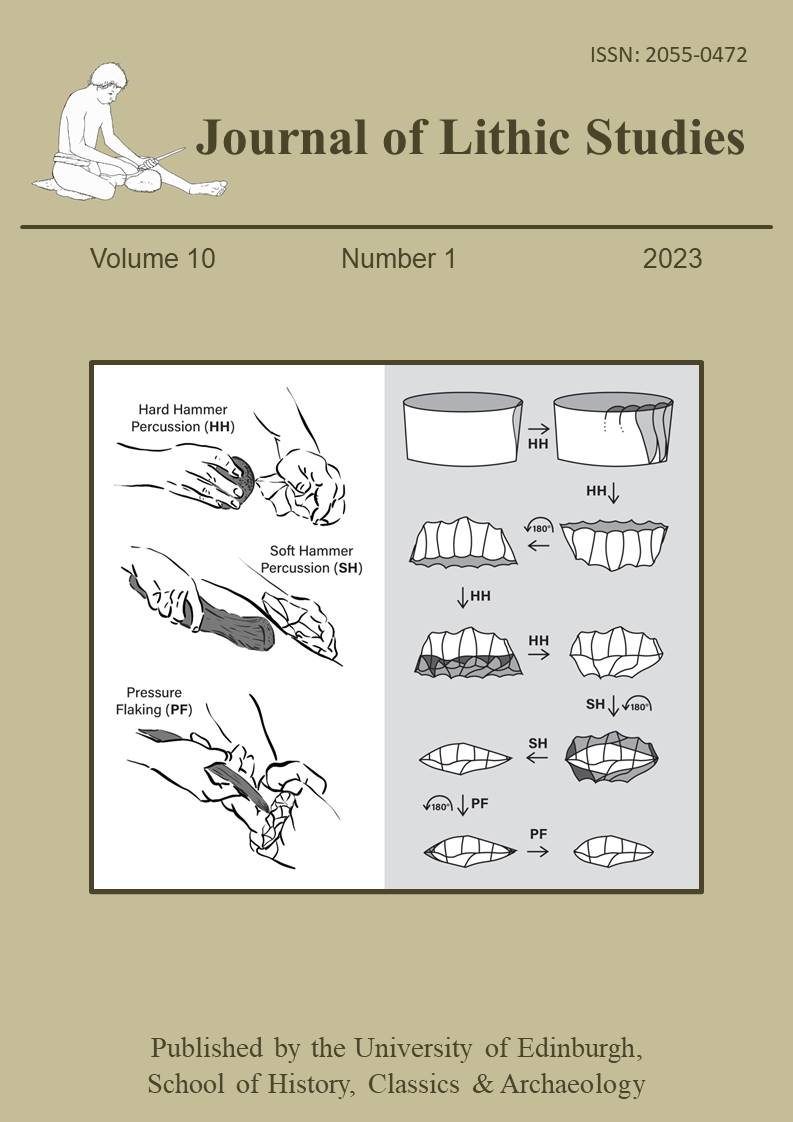Automated rapid artefact surface area measurement from imagery with computer vision
Abstract
Automated surface area measurements have been of interest to archaeologists since digital imagery began allowing researchers to remotely collect artefact metrics. We present a method of automatically measuring 2D surface area from artefact planform images employing computer vision in Python. The Python script, provided as a .py file in supplementary data, creates boundaries around regions of relatively homogeneous pixels (artefacts) in the image. These bounded regions are called contours. A count of the number of pixels within each contour provides a surface area in pixels. A circular reference object provides a conversion factor for the contours, as well as a point of reference for geometric accuracy of outputs.
Measurements of 2D artefact surface area can be used in combination with measurements of length, width, thickness, and mass, or in some cases, replace such measurements. As presented, this technique provides utility to archaeology with applications to new documentation of artefacts, archived artefact images containing a scale, as well as landscape geoarchaeology and sedimentary contexts. Limitations of this type of surface area measurement include the requirement of the image background being of a solid colour heavily contrasting the artefacts being measured. Effectively, the background requirement limits deployment supporting collection of rapid field measurements from in-situ surface scatters without modification to the script or manipulation of the artefacts. Analytical applications utilizing this technique include studies of relative artefact abundance, shape and size class characterizations in artefact scatters, and redistribution of artefacts by geomorphological processes.
References
Andrefsky, W. 2005, Lithics: macroscopic approaches to analysis. (Second ed.) Cambridge Manuals in Archaeology. Cambridge, UK: Cambridge University Press, 301 p. DOI: https://doi.org/10.1017/CBO9780511810244
Barceló, J.A. 2010, Visual analysis in archaeology. An artificial intelligence approach. In: Morphometrics for nonmorphometricians (Ashraf M.T., Ed.), Lecture notes in Earth Sciences Vol. 124. Springer, Berlin Heidelberg: p. 93-156. DOI: https://doi.org/10.1007/978-3-540-95853-6
Bradski, G. 2000, The OpenCV library. Dr. Dobb’s Journal of Software Tools 120: 122–25.
Brown, C.T. 2001, The fractal dimensions of lithic reduction. Journal of Archaeological Science 28(6): 619–31. DOI: https://doi.org/10.1006/jasc.2000.0602
Byrd, J.E. & Owens, D.D. 1997, A method for measuring relative abundance of fragmented archaeological ceramics. Journal of Field Archaeology, 24(3): 315–20. DOI: https://doi.org/10.1179/009346997792208168
Cadieux, N. 2013, Size matters: measuring debitage area and getting it right with a digital scanner. Lithic Technology, 38(1): 46–70. DOI: https://doi.org/10.1179/0197726113Z.0000000004
Canny, J. 1986, A computational approach to edge detection. IEEE Transactions on Pattern Analysis and Machine Intelligence 8(6): 679–98. DOI: https://doi.org/10.1109/TPAMI.1986.4767851
Contreras, D.A. 2010, Reconstructing an engineered environment in the central andes: landscape geoarchaeology at Chavín de Huántar, Peru. In: The Archaeology of Anthropogenic Environments (Dean, R. Ed.), Occasional Paper, No. 37. Southern Illinois University Carbondale Center for Archaeological Investigations, Carbondale, Illinois: p. 225-249.
Contreras, D.A. 2017, (Re)Constructing the sacred: landscape geoarchaeology at Chavín de Huántar, Peru. Archaeological and Anthropological Sciences, 9(6): 1045–57. DOI: https://doi.org/10.1007/s12520-014-0207-2
Harris, C.R., Jarrod Millman, K., van der Walt, S.J., Gommers, R., Virtanen, P., Cournapeau, D., Wieser, E., et al. 2020, Array programming with NumPy. Nature, 585: 357–62. DOI: https://doi.org/10.1038/s41586-020-2649-2
Holliday, V.T. 2009, Geoarchaeology and the search for the first americans. CATENA, Developments in International Geoarchaeology, 78(3): 310–22. DOI: https://doi.org/10.1016/j.catena.2009.02.014
Holliday, V.T., Harvey, A., Cuba, M.T. & Weber, A.M. 2019, Paleoindians, paleolakes and paleoplayas: landscape geoarchaeology of the Tularosa Basin, New Mexico. Geomorphology, 331: 92–106. DOI: https://doi.org/10.1016/j.geomorph.2018.08.012
Hunter, J.D. 2007, Matplotlib: A 2D graphics environment. Computing in Science Engineering, 9(3): 90–95. DOI: https://doi.org/10.1109/MCSE.2007.55
Kvamme, K.L. 1988, A simple graphic approach and poor man’s clustering technique for investigating surface lithic scatter types. Plains Anthropologist, 33(121): 385–94. DOI: https://doi.org/10.1080/2052546.1988.11909418
Kvamme, K.L. 1997, Patterns and models of debitage dispersal in percussion flaking. Lithic Technology, 22 (2): 122–38. DOI: https://doi.org/10.1080/01977261.1997.11754538
Kvamme, K.L. 1998, Spatial structure in mass debitage scatters. In: Surface Archaeology, (Sullivan, A.P. Ed.), University of New Mexico Press, Albuquerque: p. 127-141.
Lewis, P.H. & Goodson, K. J. 1991, Images, databases and edge detection for archaeological object drawings. In: Computer Applications and Quantitative Methods in Archaeology 1990. (Rahtz, S. & Lockyear, K. Eds.), BAR International Series Vol. 565, Tempus Reparatum, Oxford: p. 149-153. URL: https://eprints.soton.ac.uk/250828/1/Lewis%2526Goodson.pdf
McKinney, W. 2010, Data structures for statistical computing in Python. In: Proceedings of the 9th Python in Science Conference. (van der Walt, S. & Millman, J. Eds), SciPy Organizers, Austin, Texas: p. 56–61. DOI: https://doi.org/10.25080/Majora-92bf1922-00a
McPherron, S.P. & Dibble, H.L. 1999, stone tool analysis using digitized images: examples from the Lower and Middle Paleolithic. Lithic Technology, 24(1): 38–52. DOI: https://doi.org/10.1080/01977261.1999.11720944
Rosebrock, A. 2015a, My imutils package: a series of opencv convenience functions. PyImageSearch (blog). Retrieved: February 17, 2020. URL: https://www.pyimagesearch.com/2015/02/02/just-open-sourced-personal-imutils-package-series-opencv-convenience-functions/
Rosebrock, A. 2015b, Zero-Parameter, automatic canny edge detection with Python and OpenCV. PyImageSearch (blog). Retrieved: February 17, 2020. URL: https://www.pyimagesearch.com/2015/04/06/zero-parameter-automatic-canny-edge-detection-with-python-and-opencv/
Rosebrock, A. 2016, Measuring size of objects in an image with opencv. PyImageSearch (blog). Retrieved: February 17, 2020. URL: https://www.pyimagesearch.com/2016/03/28/measuring-size-of-objects-in-an-image-with-opencv/
Van Rossum, G. 2021, Python 3.7 reference manual. Python Software Foundation, Beaverton, Oregon. Accessed: October 17, 2023. URL: https://docs.python.org/3.7/download.html.
Sadekar, K. & Mallick, S. 2020, Camera calibration using OpenCV. Learn OpenCV (blog). 2020. URL: https://learnopencv.com/camera-calibration-using-opencv/
Virtanen, P., Gommers, R., Oliphant, T.E., Haberland, M., Reddy, T., Cournapeau, D., Burovski, E., et al. 2020, SciPy 1.0: Fundamental algorithms for scientific computing in Python. Nature Methods, 17: 261–72. DOI: https://doi.org/10.1038/s41592-019-0686-2
Weatherbee, W. 2020, A quarter and a camera ─ measuring relative abundance of artifacts with computer vision in Python. DigitalArchNS (blog). Retrieved: February 18, 2020. URL: https://github.com/weslyfe/weslyfe.github.io/blob/master/_posts/2020-02-18-measureartifacts.md

This work is licensed under a Creative Commons Attribution 4.0 International License.

This is an Open Access journal. All material is licensed under a Creative Commons Attribution 4.0 International (CC BY 4.0) licence, unless otherwise stated.
Please read our Open Access, Copyright and Permissions policies for more information.







